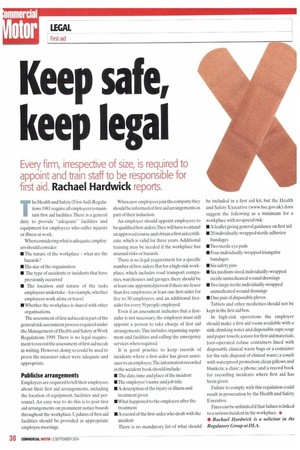Keep safe, keep legal
Page 38

If you've noticed an error in this article please click here to report it so we can fix it.
Every firm, irrespective of size, is required to appoint and train staff to be responsible for first aid. Rachael Hardwick reports.
The Health and Safety (First Aid) Regulations 1981 require all employers to maintain first aid facilities. There is a general duty to provide "adequate" facilities and equipment for employees who suffer injuries or illness at work.
When considering what is adequate, employers should consider: • The nature of the workplace — what are the hazards?
• The size of the organisation • The type of accidents or incidents that have previously occurred • The location and nature of the tasks employees undertake — for example, whether employees work alone or travel • Whether the workplace is shared with other organisations.
The assessment of first aid needs is part of the general risk assessment process required under the Management of Health and Safety at Work Regulations 1999. There is no legal requirement to record the assessment of first aid needs in writing. However, doing so could he used to prove the measures taken were adequate and appropriate.
Publicise arrangements
Employers are required to tell their employees about their first aid arrangements, including the location of equipment, facilities and personnel. An easy way to do this is to post first aid arrangements on prominent notice boards throughout the workplace. Updates of first aid facilities should be provided at appropriate employee meetings. When new employees join the company they should be informed of first aid arrangements as part of their induction.
An employer should appoint employees to be qualified first-aiders.They will have to attend an approved course and obtain a first aid certificate, which is valid for three years. Additional training may be needed if the workplace has unusual risks or hazards.
There is no legal requirement for a specific number of first-aiders. But for a high-risk workplace, which includes road transport companies, warehouses and garages, there should be. at least one appointed person if there are fewer than five employees; at least one first-aider for five to 50 employees; and an additional firstalder for every 50 people employed.
Even if an assessment indicates that a firstaider is not necessary, the employer must still appoint a person to take charge of first aid arrangements. This includes organising equipment and facilities and calling the emergency services when required.
It is good practice to keep records of incidents where a first-aider has given assistance to an employee.The information recorded in the accident book should include: • The date, time and place of the incident • The employee's name and job title • A description of the injury or illness and treatment given • What happened to the employee after the treatment • A record of the first-aider who dealt with the incident There is no mandatory list of what should be included in a first aid kit, but the Health and Safety Executive (www.hse.gov.uk) does suggest the following as a minimum for a workplace with no special risk: • A leaflet giving general guidance on first aid • 20 individually-wrapped sterile adhesive bandages • Two sterile eye pads • Four individually-wrapped triangular bandages • Six safety pins • Six medium-sized, individually-wrapped sterile unmedicated wound dressings • Two large sterile individually-wrapped unmedicated wound dressings • One pair of disposable gloves.
Tablets and other medicines should not be kept in the first aid box.
In high-risk operations the employer should make a first aid room available with a sink; drinking water and disposable cups; soap and paper towels; a store for first aid materials; foot-operated refuse containers lined with disposable clinical waste bags or a container for the safe disposal of clinical waste; a couch with waterproof protection; clean pillows and blankets; a chair; a phone; and a record book for recording incidents where first aid has been given.
Failure to comply with this regulation could result in prosecution by the Health and Safety Executive.
Fines can be unlimited if that failure is linked to a serious incident in the workplace. si • Rachael Hardwick is a solicitor in the Regulatory Group at DLA.




























































































































































































